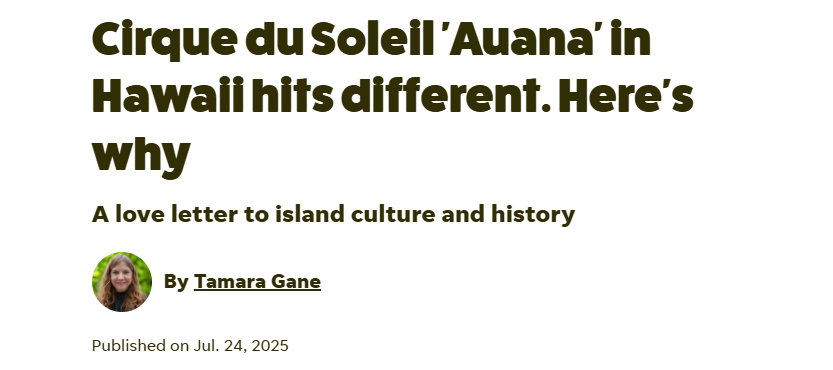
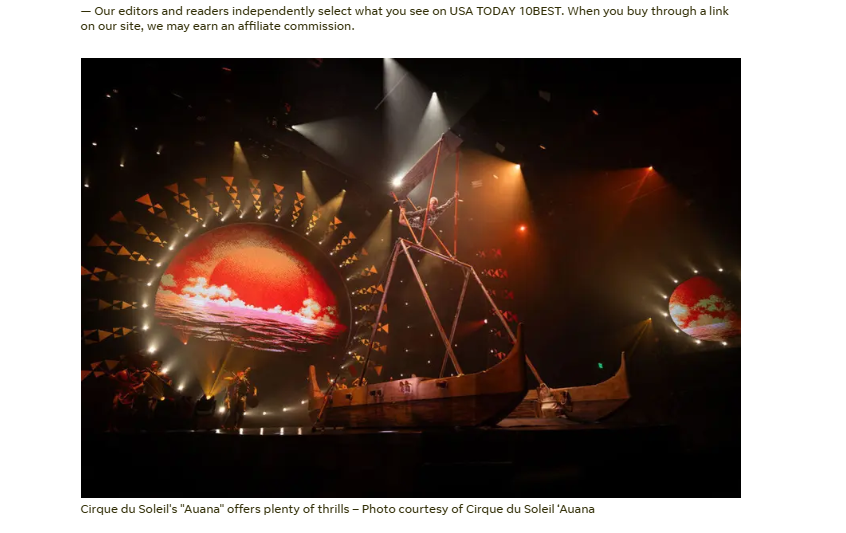
I’ll admit that I wasn’t sure what to expect when my boyfriend and I decided to attend a performance of Cirque du Soleil “Auana” during a trip to Honolulu. We spend a lot of time in Las Vegas, and we’ve seen our share of Cirque du Soleil shows. We love them and didn’t doubt that the show would be entertaining; we just thought it might feel like another Vegas experience rather than a Hawaiian experience.
This wasn’t the case. Cirque du Soleil “Auana” manages to walk a mesmerizing tightrope of excitement and thrills rooted in authentic Hawaiian culture. Without giving too much away, the production begins before you’re aware the show has even started. This sets the stage for an immersive experience where performers flit between the stage and the ceiling, often blurring the line between performance and reality.
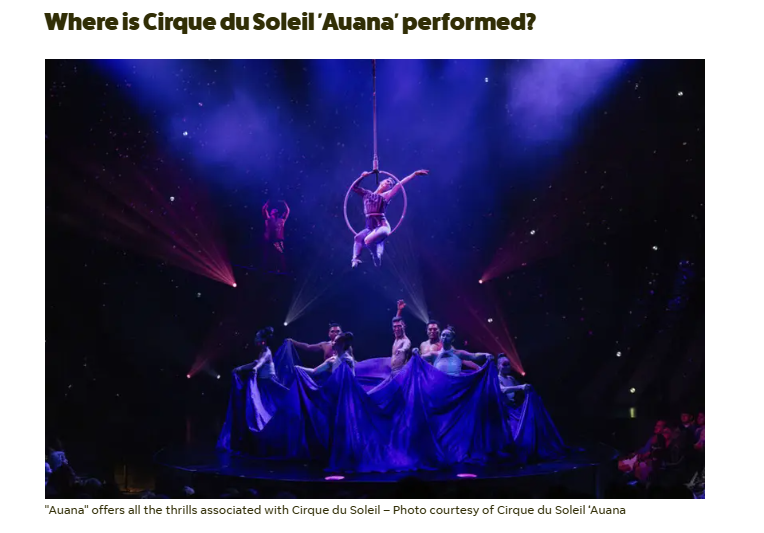
Cirque du Soleil’s “Auana” opened at the end of 2024 at the Outrigger Waikiki Beachcomber Hotel in Honolulu. The 784-seat theater was custom-designed for the production. The audience is positioned around a three-sided stage known as a “thrust stage.” It’s a more intimate environment than the Las Vegas productions, which generally seat over 100 guests. The immediacy of the venue sparks an instant connection between the performers and the audience.
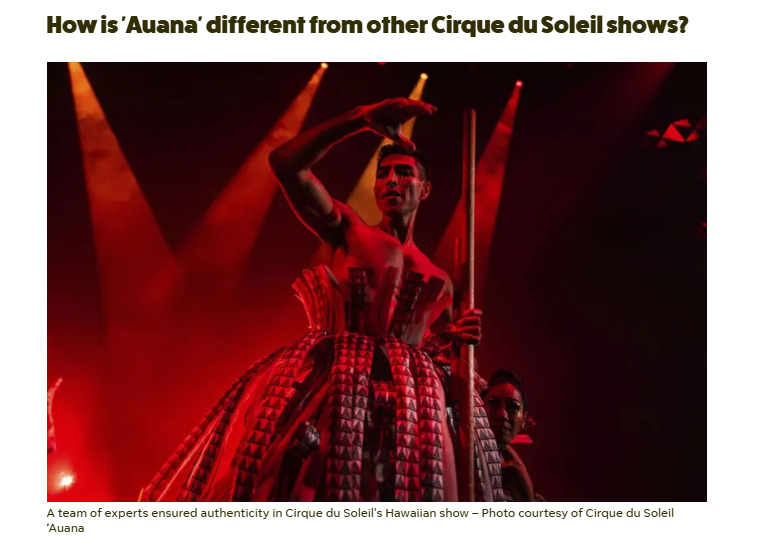
When Cirque du Soleil expressed interest in creating a show in Waikiki, one of the top priorities for cultural creative director Aaron Salā was to ensure that Hawaiian culture was represented authentically, with respect, and in depth.
The team behind the show includes cultural leaders and creatives, such as Kumu Hula Hiwa Vaughan, who choreographed the hula, and renowned designer Manaola Yap, who served as the show’s official costume designer. Director Neil Dowrward eagerly immersed himself in the culture, as he received a crash course in all things Hawaii. The result is a creative vision deeply informed by the islands’ traditions and values.
Cirque du Soleil’s “Auana” unfolds across eight chapters, drawing inspiration from Hawaii’s moʻolelo stories, which have been passed down through the oral tradition from one generation to the next. We watched as a character known as Trickster embarked on a journey through space and time, transporting us from the Polynesian migration to the “golden age of tourism.”
Auana means “to wander” in Hawaiian. The word also describes modern hula, which combines flowing movements with musical elements, such as the ukulele and guitar.
Music and hula are integral to the show. Esteemed Hawaiian language expert Keao NeSmith developed original lyrics in Olelo Hawaii, the indigenous language of Hawaii, which, along with English, is the state’s official language.
Although I understood the importance of remaining faithful to the Hawaiian language, I worried I might have trouble connecting with a show performed in a language I don’t understand. However, I found that the music and lyrics were woven so beautifully into the fabric of the show that I didn’t need to understand the lyrics. I felt them.
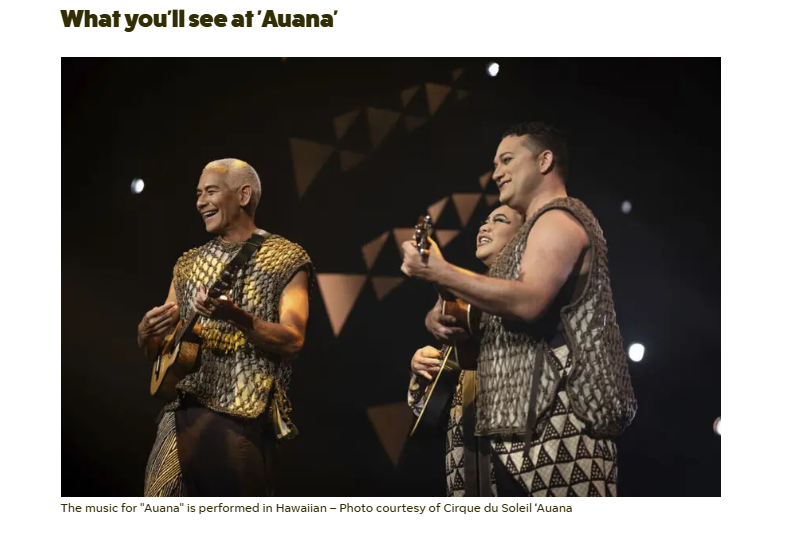
One of my favorite vignettes featured surfing, a sport invented in ancient Polynesia and closely associated with Hawaii. The performance opened with a man standing on a surfboard placed on a wheel. It seems improbable enough that he would be able to balance and “surf” on top of it, but if you’ve ever seen a Cirque du Soleil show, you know that just when you think a feat is impossible, they make it even harder.
When more cylinders were added, I gasped along with the audience as he maintained his balance on a tower of rounds that seemed as tall as he was.
Another favorite scene brought comic relief as volunteers from the audience joined Trickster onstage in a celebration of Hawaiian pop culture. (I’m being deliberately vague because it’s a fun moment when it all comes together and you realize what’s happening.)
The story culminates in a spectacular finish, with two warriors performing stunts, leaping in and out of enormous, moving cylinders in feats so daring that the audience moves from gasps to applause every few seconds. I wanted them to stop because I worried they might harm themselves, but I also wanted them to continue, because it was so exciting. Their exhilarating performances left no doubt that “Auana” was as much Cirque du Soleil as it was authentically Hawaiian.
I rarely have the desire to attend a show more than once, but I plan to see “Auana” again the next time I’m in Oahu.
I won’t be alone. Salā says the show is a hit with both visitors and locals. “Audiences have particularly enjoyed the blend of cultural elements … with Cirque’s signature acrobatics,” he says. “This fusion has created a memorable experience that resonates deeply with diverse audiences.”
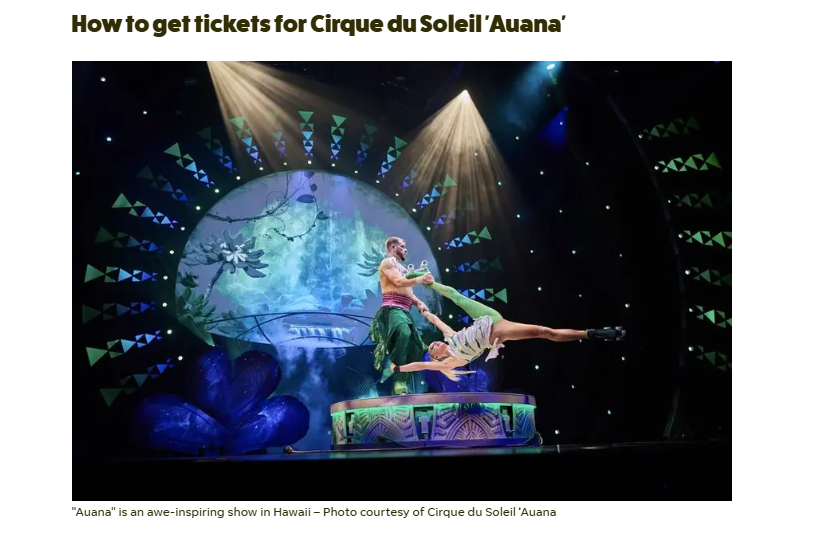
You can purchase tickets online at Cirque du Soleil, via Stubhub, or by calling the box office at 1-877-924-7783. When purchased directly through Cirque du Soleil, discounted tickets are available to locals, military personnel, and families purchasing four or more tickets. Special group pricing and theater buyouts are also available. Discounted tickets are available for children aged 3 to 11 years old. Children 2 years old and under can attend for free if they sit on a parent’s lap.
Know before you go
Cirque du Soleil’s ‘Auana currently performs at 5:30 pm and 8:00 pm, Wednesday through Sunday. The show is suitable for all ages. The theater is fully accessible to all guests, including those with disabilities. Find it inside Outrigger Waikiki Beachcomber Hotel on Kalakaua Avenue, between Duke’s Lane and Kaiulani Avenue. Public parking is available at the nearby International Market Place or Waikiki Parking Garage.
About the Author
Tamara Gane
Tamara Gane is an expert panel member for 10Best Readers’ Choice Awards. She’s based in Reno/Lake Tahoe and in addition to USA TODAY 10Best, her work has been published in Travel & Leisure, Fodor’s Travel, The Washington Post, SF Gate, Houston Chronicle, Lonely Planet, and more.
###
Read the story on USA Today, HERE